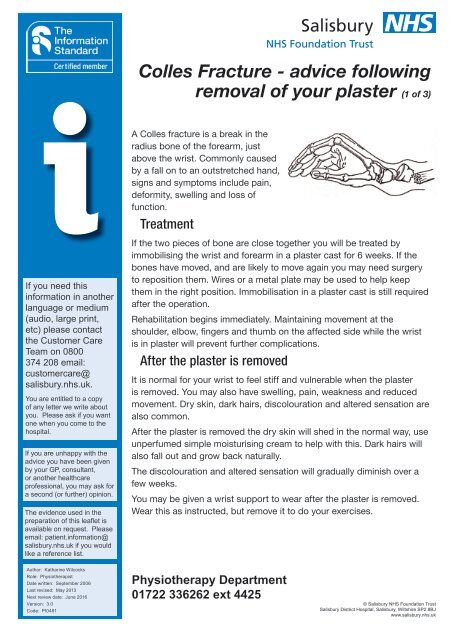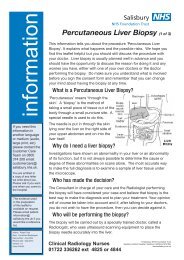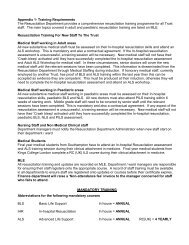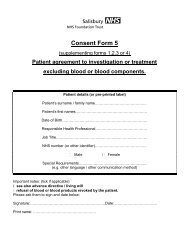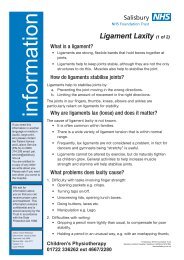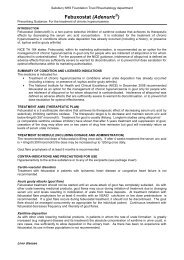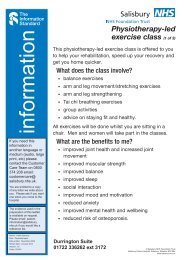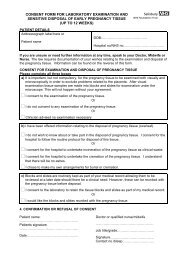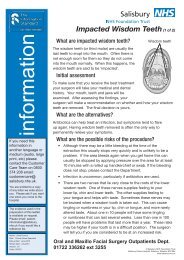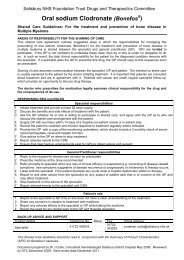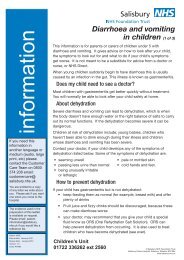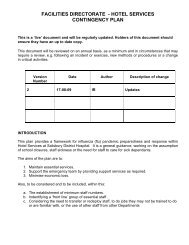Colles Fracture - ICID - Salisbury NHS Foundation Trust
Colles Fracture - ICID - Salisbury NHS Foundation Trust
Colles Fracture - ICID - Salisbury NHS Foundation Trust
You also want an ePaper? Increase the reach of your titles
YUMPU automatically turns print PDFs into web optimized ePapers that Google loves.
i<br />
If you need this<br />
information in another<br />
language or medium<br />
(audio, large print,<br />
etc) please contact<br />
the Customer Care<br />
Team on 0800<br />
374 208 email:<br />
customercare@<br />
salisbury.nhs.uk.<br />
You are entitled to a copy<br />
of any letter we write about<br />
you. Please ask if you want<br />
one when you come to the<br />
hospital.<br />
If you are unhappy with the<br />
advice you have been given<br />
by your GP, consultant,<br />
or another healthcare<br />
professional, you may ask for<br />
a second (or further) opinion.<br />
The evidence used in the<br />
preparation of this leaflet is<br />
available on request. Please<br />
email: patient.information@<br />
salisbury.nhs.uk if you would<br />
like a reference list.<br />
<strong>Colles</strong> <strong>Fracture</strong> - advice following<br />
removal of your plaster (1 of 3)<br />
A <strong>Colles</strong> fracture is a break in the<br />
radius bone of the forearm, just<br />
above the wrist. Commonly caused<br />
by a fall on to an outstretched hand,<br />
signs and symptoms include pain,<br />
deformity, swelling and loss of<br />
function.<br />
Treatment<br />
If the two pieces of bone are close together you will be treated by<br />
immobilising the wrist and forearm in a plaster cast for 6 weeks. If the<br />
bones have moved, and are likely to move again you may need surgery<br />
to reposition them. Wires or a metal plate may be used to help keep<br />
them in the right position. Immobilisation in a plaster cast is still required<br />
after the operation.<br />
Rehabilitation begins immediately. Maintaining movement at the<br />
shoulder, elbow, fingers and thumb on the affected side while the wrist<br />
is in plaster will prevent further complications.<br />
After the plaster is removed<br />
It is normal for your wrist to feel stiff and vulnerable when the plaster<br />
is removed. You may also have swelling, pain, weakness and reduced<br />
movement. Dry skin, dark hairs, discolouration and altered sensation are<br />
also common.<br />
After the plaster is removed the dry skin will shed in the normal way, use<br />
unperfumed simple moisturising cream to help with this. Dark hairs will<br />
also fall out and grow back naturally.<br />
The discolouration and altered sensation will gradually diminish over a<br />
few weeks.<br />
You may be given a wrist support to wear after the plaster is removed.<br />
Wear this as instructed, but remove it to do your exercises.<br />
Author: Katharine Wilcocks<br />
Role: Physiotherapist<br />
Date written: September 2006<br />
Last revised: May 2013<br />
Next review date: June 2016<br />
Version: 3.0<br />
Code: PI0481<br />
Physiotherapy Department<br />
01722 336262 ext 4425<br />
© <strong>Salisbury</strong> <strong>NHS</strong> <strong>Foundation</strong> <strong>Trust</strong><br />
<strong>Salisbury</strong> District Hospital, <strong>Salisbury</strong>, Wiltshire SP2 8BJ<br />
www.salisbury.nhs.uk
Exercises<br />
<strong>Colles</strong> <strong>Fracture</strong> - advice following removal of your plaster (2 of 3)<br />
Exercise is a very important part of your rehabilitation. The discomfort in your wrist will reduce<br />
with exercise, but it is likely to ache until it is fully mobile.<br />
For all exercises start off with 5 repetitions and progress up to 10 over a few days. Do the<br />
exercises slowly and gently to begin with. Continue the exercises until you feel you have the<br />
range of movement and strength to carry out your daily activities.<br />
The Queen’s wave<br />
Rest your elbow on a table with the hand held up. Support<br />
your forearm by holding with your other hand. Keep your<br />
forearm still whilst moving your hand.<br />
Prayer position<br />
With your forearms resting on a table,<br />
push your palms together to perform the ‘prayer position’.<br />
Getting change in the shop<br />
Keep your elbow bent and tucked into your side. Turn your hand over so the<br />
palm faces the ceiling (ensure your elbow is kept still) then twist your wrist so<br />
the palm faces the floor.<br />
Finger to thumb (opposition)<br />
Move your thumb to touch the tip of each finger.<br />
Making a fist<br />
Curl your fingers round to make a fist and then straighten fully.<br />
Flexing and extending your wrist<br />
Place your arm on a table with your hand relaxed over the edge of the table.<br />
Move your wrist up and down as far as you can. You can also use your other<br />
hand to give a little stretch.<br />
Physiotherapy Department<br />
01722 336262 ext 4425<br />
© <strong>Salisbury</strong> <strong>NHS</strong> <strong>Foundation</strong> <strong>Trust</strong><br />
<strong>Salisbury</strong> District Hospital, <strong>Salisbury</strong>, Wiltshire SP2 8BJ<br />
www.salisbury.nhs.uk
<strong>Colles</strong> <strong>Fracture</strong> - advice following removal of your plaster (3 of 3)<br />
What else can help?<br />
• Taking regular pain relief helps you to perform more effective physiotherapy exercises.<br />
• When resting keep your arm raised on pillows to help reduce the swelling<br />
• Practising wrist and finger movements with the hand and wrist in warm water can help<br />
ease stiffness.<br />
• Soak your hand in warm soapy water. Rub the skin gently and pat dry. Use an unperfumed<br />
moisturising cream.<br />
• If your wrist and hand are swollen and feeling hot, you can apply an ice pack or packet of<br />
frozen peas wrapped in a tea towel. Only use for 10 minutes at a time.<br />
Physiotherapy<br />
After your <strong>Colles</strong> fracture, you may not necessarily be referred for physiotherapy. However, if you<br />
struggle to improve your wrist movement, please speak to your GP or consultant.<br />
When can I return to work?<br />
This will depend on the type of work that you do; ask your consultant or physiotherapist. Avoid<br />
heavy work for at least 6 weeks after your plaster is removed or until advised by your Consultant<br />
or Physiotherapist.<br />
If your symptoms worsen significantly please contact the Orthopaedic Therapy Team, Outpatient<br />
Physiotherapy (if you have been referred) or Orthopaedic Outpatients.<br />
Physiotherapy Department<br />
01722 336262 ext 4425<br />
© <strong>Salisbury</strong> <strong>NHS</strong> <strong>Foundation</strong> <strong>Trust</strong><br />
<strong>Salisbury</strong> District Hospital, <strong>Salisbury</strong>, Wiltshire SP2 8BJ<br />
www.salisbury.nhs.uk


